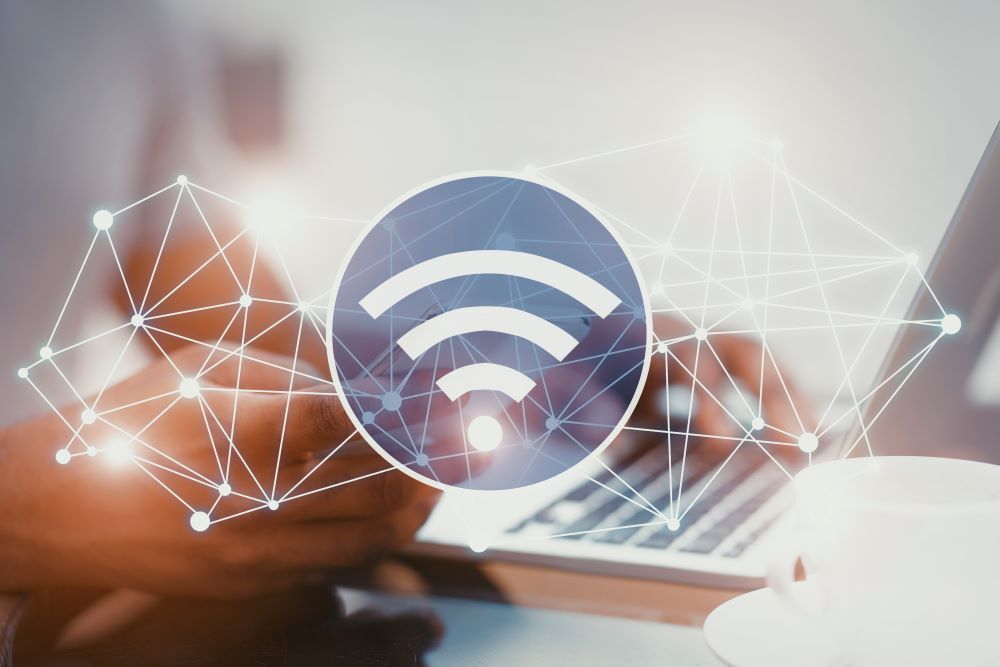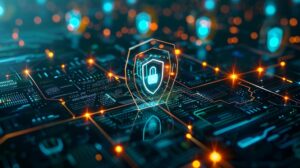
In today’s digital age, access to public Wi-Fi networks has become an everyday convenience, offering instant connectivity in a variety of locations including cafés and airports. However, this convenience can also expose users to significant security risks.
Our IT outsourcing experts guide you through the potential dangers of public Wi-Fi, and suggest practical strategies to secure your data against potential cyber-attacks.
What is public Wi-Fi?
A public Wi-Fi network is a wireless Wi-Fi access point offered in a public space like a café, library, airport or hotel.
However, unlike private networks, which are secured by passwords and encryption protocols to protect users’ confidential data, public Wi-Fi networks are widely accessible, making them potentially vulnerable to malicious activity.
Risks of public Wi-Fi
When you connect to a public Wi-Fi network, you put yourself at risk to various online browsing threats. By knowing the dangers associated with open networks, you can protect yourself properly and adopt appropriate cybersecurity measures.
Man in the Middle (MitM) attacks and espionage
Hackers using public networks can monitor your online activities using advanced techniques like Man-in-the-Middle (MITM) attacks. They use various tactics to intercept sensitive data, such as private conversations or details about a bank account, and collect sensitive information.
Connecting to a fake (fraudulent) Wi-Fi network
Hackers can easily create fraudulent Wi-Fi access points that mimic legitimate connections. These fake, booby-trapped Wi-Fi networks are designed to steal your personal information when you connect to them.
Spreading malware and ransomware
On public Wi-Fi networks, users are vulnerable to various risks including the spread of malware. Malware can severely damage device systems and facilitate spying on online activities or stealing personal information. Ransomware also poses a significant threat: attackers can restrict access to crucial data or encrypt files, then demand a ransom to unblock them. These practices jeopardize the security and confidentiality of public Wi-Fi users.
Vulnerability to denial-of-service (DoS) attacks
A Denial of Service (DoS) attack involves blocking access to a computer or device by disrupting its operation by flooding the target with excessive requests so legitimate traffic cannot be processed. This type of cyberattack typically uses a single computer to paralyze the targeted system, making it impossible for legitimate users to gain access.
Best practices for using public Wi-Fi networks
Using an open Wi-Fi network involves certain dangers, but by following these best practices, you can minimize the risk and surf more safely:
- Check network legitimacy: Before connecting to an open Wi-Fi network, make sure it is legitimate.
- Avoid sensitive transactions: When connected to an open network, avoid completing banking transactions, online purchases, or any activity that involves entering sensitive information like passwords or credit card numbers.
- Deactivate automatic sharing: Access your device settings and deactivate automatic sharing. This prevents other network users from accessing your files and personal information.
- Use secure websites: Make sure the websites you visit use HTTPS protocol, which is indicated by a padlock symbol next to the URL in the browser’s address bar. This symbol confirms that the connection between your browser and the website is encrypted.
- Log out after use: Once you’ve finished your session, disconnect from the open Wi-Fi network and erase the network from your device to avoid automatically connecting later.
Take extra precautions against hackers
If you connect to public Wi-Fi networks on a regular basis, there are a few preventive measure you can take to strengthen your defense against cyber attacks and protect your personal data:
- Keep your software up to date: Updates often contain security patches to combat the vulnerabilities typically exploited by hackers.
- Use security software: Install software including antivirus, anti-malware and/or firewall software, or use an EDR such as Sentinel One to detect and block threats.
- Use password managers: Use password managers to create and manage complex passwords and reduce the risk of unauthorized access.
- Enable two-factor authentication: Strengthen the security of your online accounts with two-factor authentication, which adds an extra layer of protection via a temporary code.
- Install a VPN: Using a virtual private network (VPN) can be your first line of defense against intrusions and data theft. Using a VPN encrypts data you are circulating online so that it is unreadable to anyone trying to intercept it.
Choose the right type of Wi-Fi security for your network
To guarantee optimum security for your Internet access point, opt for the “WPA3-Personal” protocol, compatible with “Wi-Fi 6” and some earlier models. If your devices are incompatible with WPA3, the “WPA2/WPA3 Transitional” mode is a reliable alternative that can facilitate a smooth transition to enhanced security.
Avoid obsolete settings such as mixed WPA/WPA2, WPA-Personal, WEP and TKIP modes, as well as settings such as “None”, “Open” or “Unsecured”, as these will make your network public and therefore vulnerable to intrusion and hacking.
Use Wi-Fi networks safely with Groupe SL!
Safe surfing on public Wi-Fi networks requires constant vigilance and the adoption of robust security practices. By following the advice of a managed IT service provider, such as checking the legitimacy of networks, proceeding carefully when doing online transactions, and securing your devices with up-to-date software and VPNs, you can significantly reduce the risks.
You can also contact Groupe SL for customized IT solutions that guarantee peace of mind. Trust Groupe SL’s expertise to make the protection of your business information a priority!





